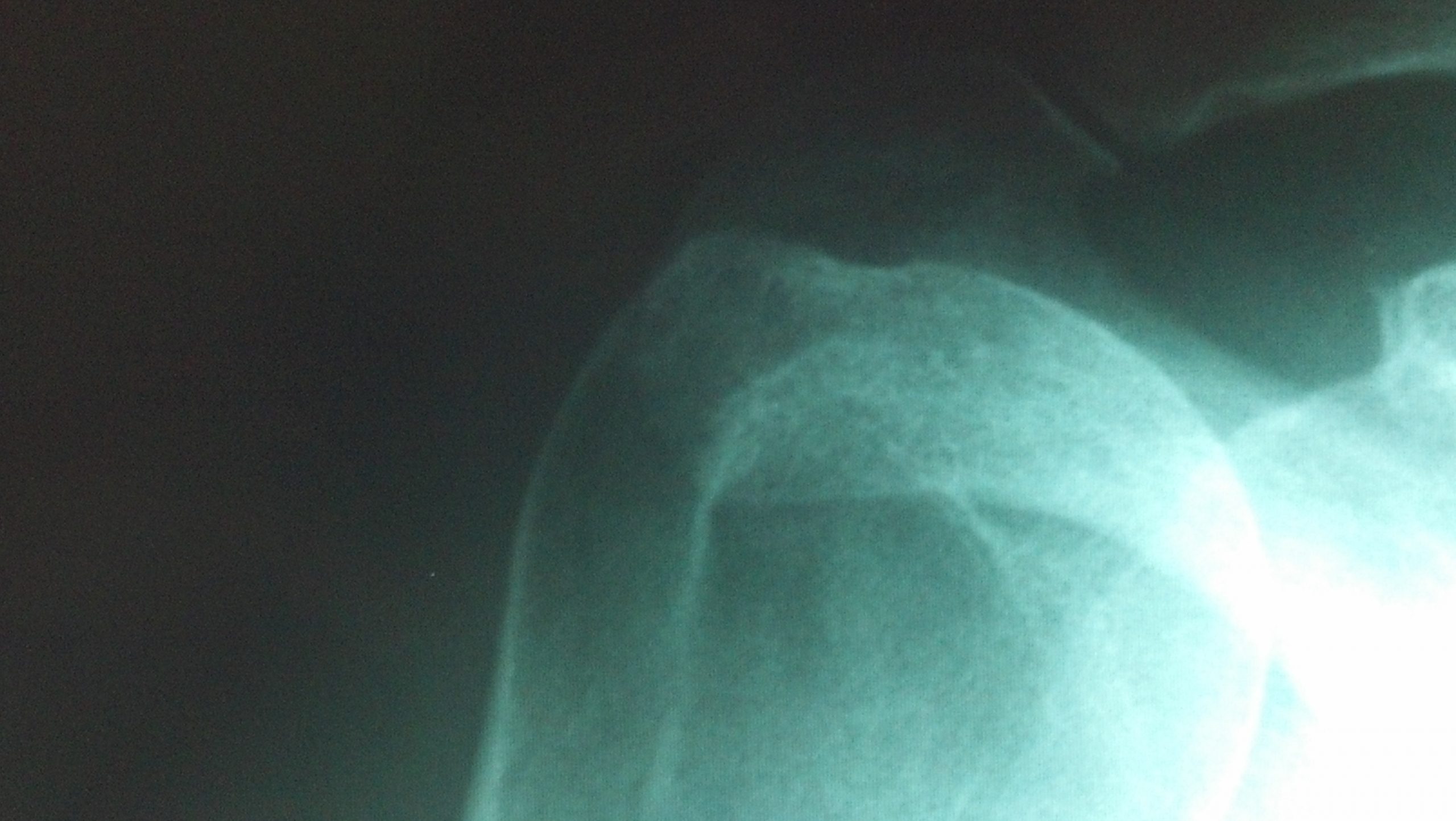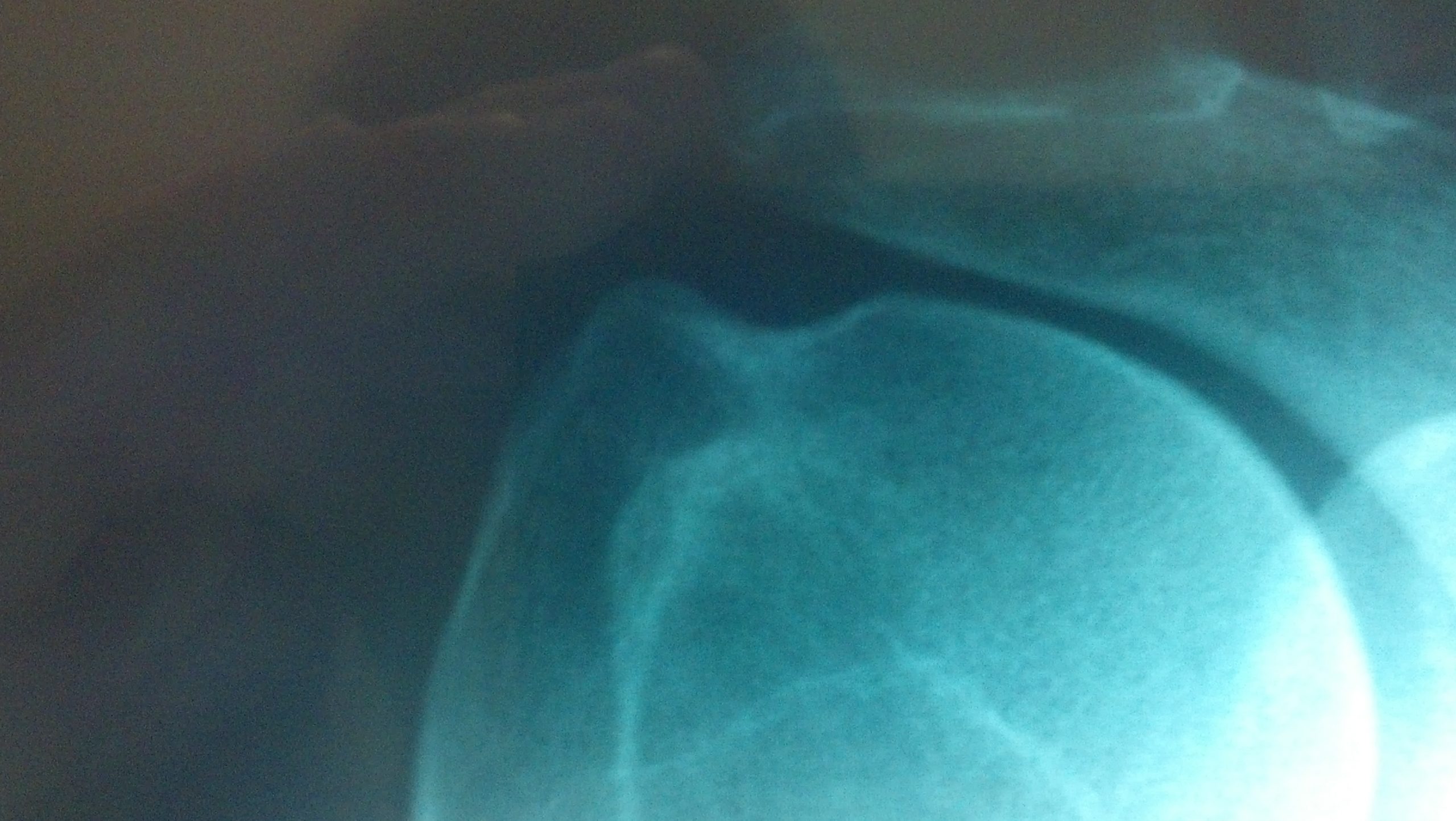- See: Total Shoulder Replacement
- Technique:
- deliver the proximal humerus:
- anteriorly dislocate the humeral head by extending, abducting, and externally rotating the arm;
- a blunt Homan retractor is then placed behind the humeral head to maintain its dislocated position;
- arm is then extended, adducted, and externally rotated and inaddition, the humerus is translated proximally (pushing up under
elbow) in order to maximize the exposure of the humeral head;
- determine native humeral head height:
- height of humeral head relative to greater tuberosity, noting that usually head lies about 8 mm (+/- 3) above greater tuberosity;
- this height differential helps in the selection of the size of the humeral head and the proudness of the stem;
- note that the head of the prosthesis should be superior to the greater tuberosity; 
- references:
- Influence of Humeral Prosthesis Height on Biomechanics of Abduction. An In Vitro Study.
- Prospective analysis of total shoulder arthroplasty biomechanics.
- The effect of articular conformity and the size of the humeral head component on laxity and motion after glenohumeral arthroplasty. A study in cadavera.
- determine native retroversion and angle of inclination:
- trim away all peripheral osteophytes around the humeral head using an osteotome and a rongeur;
- this step must be performed carefully inorder to re-establish the anatomy of the anatomical neck, which allows correct
assesment of retroversion;
- determine the native retroversion
- avg is 35 deg;
- neck-shaft angle is 130°, and the head is retroverted 19° to 22° relative to the shaft;
- references:
- Three-Dimensional Analysis of the Proximal Part of the Humerus: Relevance to Arthroplasty
- Effect of a variable prosthetic neck-shaft angle and the surgical technique on replication of normal humeral anatomy.
- lateral offset:
- restoring humeral offset is necessary for optimal rotator cuff function and shoulder ROM;
- measure the lateral offset: distance from the coracoid process to the lateral most portion of the greater tuberosity;
- note the amount of tension of the subscapularis as it is applied to its insertion before and after the components are in place;
- if the subscapularis cannot be repositioned to its insertion, then there may be increased lateral offset;
- transection of the humerus:
- determines in part, the amount of humeral retroversion;
- externally rotate the arm 30-40 deg and have the saw blade aligned directly in the AP plane of the patient (not the scapula);
- then make a "neutral cut" at the rim of the joint cartilage, in order to achieve 30-40 deg of retroversion;
- typically a humeral cutting guide is used to fine tune the cut;
- this cut should coinside w/ the version of the anatomic neck of the humerus;
- ref: A three-dimensional analysis of humeral head retroversion
- ensure that the humeral osteotomy is just inside the rotator cuff insertion but ensure that the cut does not go into
the subscapularis or the rotator cuff insertions at the superolateral portion of the anatomic neck;
- osteotomy of the humeral head that is too lateral or in excessive retroversion may disrupt the rotator cuff insertion;
- protection of cuff during resection is done placing a large curved retractor just inside the rotator cuff insertion posteriorly;
- references:
- Effect of a cooled saw blade on prosthesis fixation. Randomized radiostereometry of 33 knee cases.
- On the problem of heat generation in bone cutting. Studies on the effects on liquid cooling.
- entry into intramedullary canal:
- starting reamer is inserted into IM canal at a point 3 mm from highest point of cut (which is just adjacent to greater tuberosity;
- placing reamers into the mid-portion of the transected surface will result in the component being placed in varus which will
over-stuff joint when the arm is at the side (which makes the tuberosities proud);
- note the retroversion:
- carefully broach medullary canal w/ care taken to place lateral fin of broach slightly posterior to center of bicipital groove;
- keeping the broach fin just posterior to the bicipital grove will give about 30 deg of retroversion;
- note that the mean distance between the deepest point of the bicipital groove and the center line of the rasp will be 8 mm;
- if posterior glenoid bone loss is present, consider altering amount of humeral retroversion from the normal 35 deg
to a less retroverted position;
- attempt to recreate the normal humeral head height, which is approximately 2-5 mm above the tuberosities;
- be sure that the humeral component is not left proud because it will excessively tightens the capsule as arm is elevated,
and limits elevation;
- references:
- Surgical landmarks to determine humeral head retrotorsion for hemiarthroplasty in fractures.
- Bicipital groove orientation: considerations for the retroversion of a prosthesis in fractures of the proximal humerus.
- Analysis of the bicipital groove as a landmark for humeral head replacement.
- Selection of Humeral Component:
- cement or press fit stems;
- cement augmentation should be used if bone quality is poor or if metaphyseal bone deficiency is present;
- cementing also allows the component to be left proud (if necessary) inorder to re-create humeral length and soft tissue tension;
- press fit systems do not allow precise titration of humeral length, and should probably be used with caution in 4 part frx (where
tuberosities are quatered off the femur);
- remember that the the humeral head lies slightly above the top of the greater tuberosity (up to 1 cm);
- reference:
- The early results of porous-coated total shoulder arthroplasty.
- size considerations:
- its essential to restore the anatomic length of the humerus to provide the proper amount of tension in the deltoid so that the
patient will maintain the ability to forward flex;
- remove osteophytes from around the humeral head, as they will make the humeral head seem bigger than it is;
- when in doubt about the best humeral head size choose the smaller humeral head size;
- avoid oversizing the humeral head:
- oversizing the prosthetic humeral head may significantly reduce laxity of the joint and ROM;
- can result in pain, shoulder stiffness, and compromise of the rotator cuff;
- can lead to obligate translation at the extremes of motion;
- in the report by Robertson DD et al (2000), the authors studied the anatomy of 60 cadaveric humeri;
- average humeral head thickness was 19 mm;
- humeral head inclination averaged 41 deg but was less variable than previously described, with 95 % of sample within
range of 35 to 46 deg;
- proximal humeral retroversion was variable and averaged 19 degrees;
- average diameter in males was 48 +/- 4 mm, and in females 44 +/- 4 mm;
- reference:
- Three-Dimensional Analysis of the Proximal Part of the Humerus: Relevance to Arthroplasty
- Third generation of humeral implants
- second generation components less modular and limit anatomic replication of humeral head component
- ref: Geometric Analysis of Commonly Used Prosthetic Systems for Proximal Humeral Replacement
- modular humeral components allow for more anatomic replication of humeral head component
- axis of humeral shaft is identified and prepared anatomically
- humeral shaft axis is generally offset anterior and lateral to humeral head center of rotation
- neck-shaft angle is also variable with average of 135 degrees
- these discrepancies are accommodated by modular implants.
- adjustable parameters include neck-shaft angle, size of humeral head, and eccentric humeral head components
- ref: The three dimensional geometry of the proxial humerus: Implications for surgical technique and prosthetic design
- soft tissue tension:
- ensure that all periarticular osteophytes are removed from both sides of the shoulder joint;
- adhesions from the base of the coracoid process were released;
- avoid excessively large components and neck lengths as this increases capsular tension and decreases motion and
increases instability;
- surgeon should be able to pass one finger between the acromion and the prosthetic head, should be able to inferiorly
translate the humeral head so that one half of the glenoid is exposed;
- posterior translation: humeral head component should allow enough posterior translation in order to allow exposure of
anterior half of the glenoid (about 15 mm of posterior translation);
- rotation: the abducted arm should allow 70 deg of internal rotation (w/ arm abducted) and 40 deg of external rotation (w/
subscapularis approximated)
- excessive humeral head size will increase rotator cuff tension (increase tension on the subscapularis repair site);
- hand on involved side could be placed on superior aspect of contralateral shoulder without protraction of the scapula;
- if TSR is being performed for a four part fracture than the component should be equipped with a fin for reattachement of
the tuberosities;
- reference:
- The effect of articular conformity and the size of the humeral head component on laxity and motion after glenohumeral arthroplasty. A study in cadavera.









